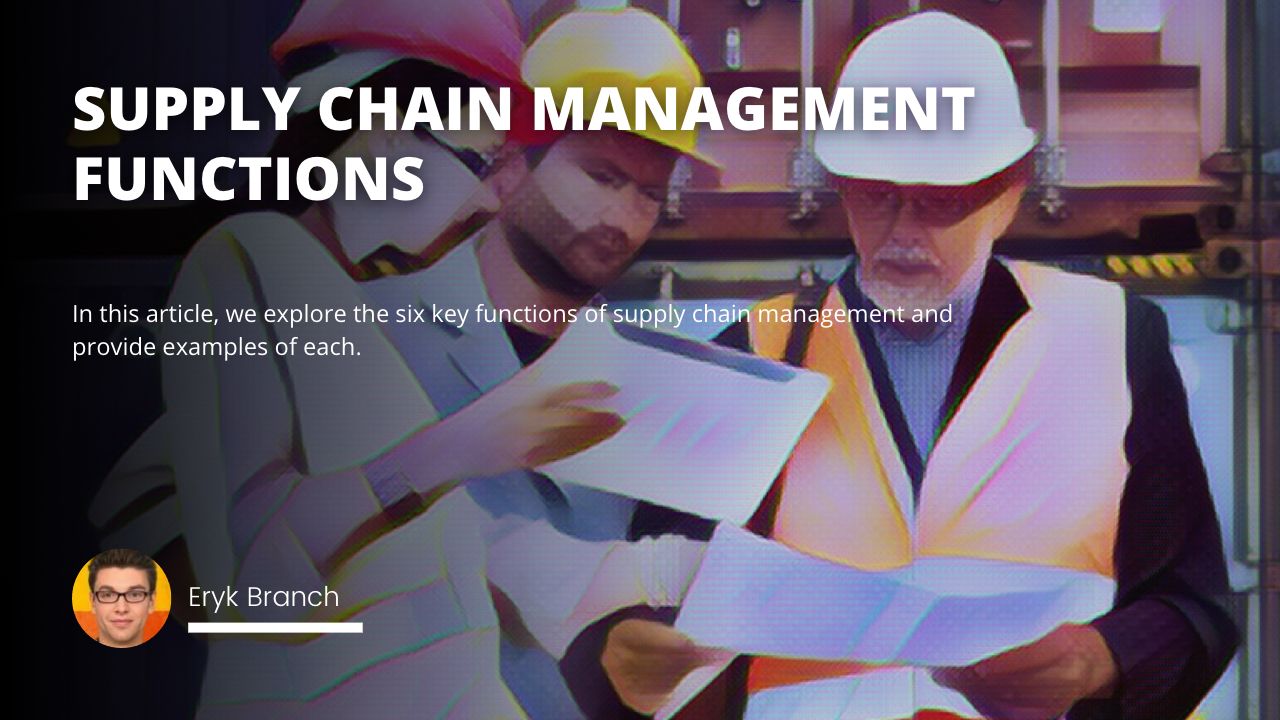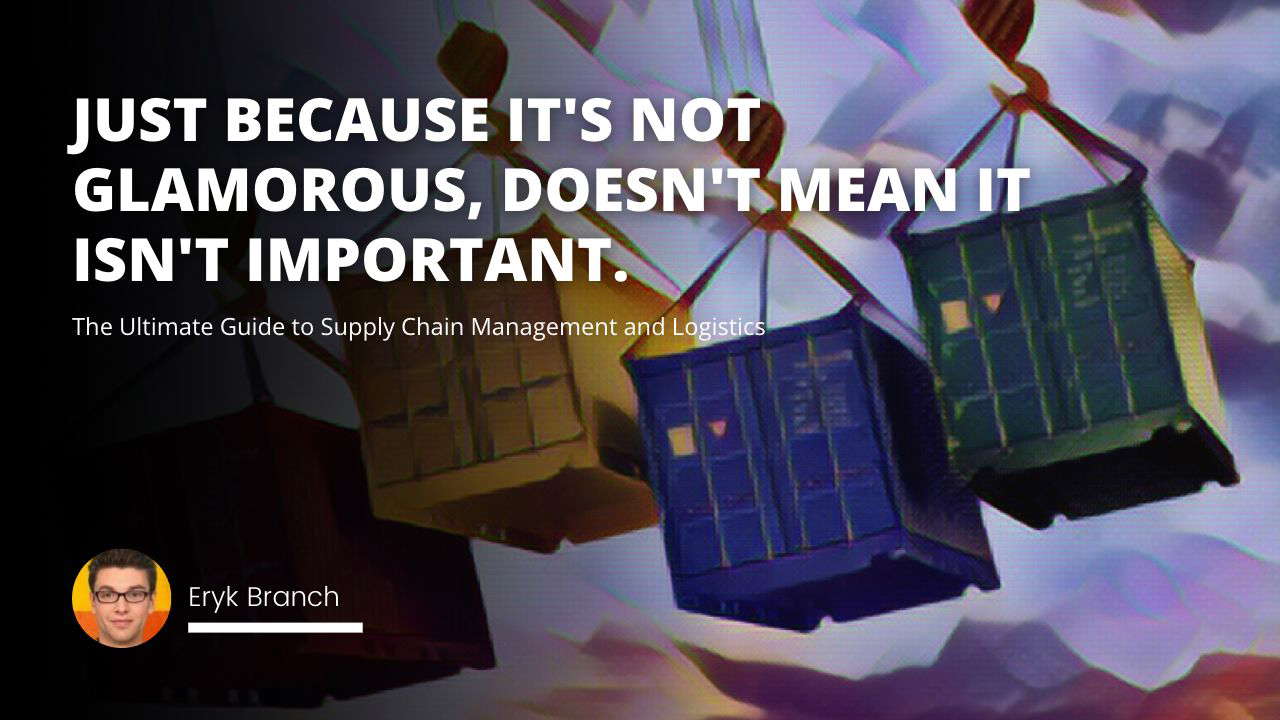
This article discusses the importance of inventory planning and management, the impact of inadequate inventory levels, the benefits of optimizing inventory levels, the advantages of integrating inventory planning with logistics network planning, and strategies for implementation.
Businesses need to balance inventory levels and logistics network planning to optimize customer service, increase profitability, and streamline operations.
Introduction
Impact of Inadequate Inventory Levels
Benefits of Optimizing Inventory Levels
Integrating Inventory Planning with Logistics Network Planning
Conclusion
Introduction: Logistics management is a crucial function in any business, and inventory planning and management are essential parts of this process. Inventory planning and management determine how much inventory to keep on hand, where and when it should be stored, and how it should be distributed.
Related course: Logistics Management Course
It is essential to get the balance right, as inadequate inventory levels can negatively affect customer service and lead to financial losses and operational inefficiencies. At the same time, too much inventory can also lead to financial losses and operational inefficiencies. Therefore, optimizing inventory levels and integrating inventory planning with overall logistics network planning activities is crucial.
Impact of Inadequate Inventory Levels
Inadequate inventory levels can have a significant impact on customer service. If customers cannot find the products they need when they need them, it can lead to lost sales and dissatisfied customers.
In addition, inadequate inventory levels can lead to financial losses, as the firm has to spend money to replace or replenish inventory. Furthermore, inadequate inventory levels can lead to operational inefficiencies, such as overcrowded warehouses, long lead times, and increased costs associated with expedited shipping.
Benefits of Optimizing Inventory Levels
Optimizing inventory levels can have a significant impact on a business. By ensuring enough inventory to meet customer demand, customer service can be improved, leading to increased sales and satisfied customers.
In addition, optimizing inventory levels can lead to increased profitability, as the firm can reduce costs associated with purchasing and storing excess inventory. Finally, optimizing inventory levels can lead to streamlined operations, as there is less need for expedited shipping and overcrowded warehouses.
Integrating Inventory Planning with Logistics Network Planning
Integrating inventory planning with overall logistics network planning activities can have several benefits. By considering the needs of the entire logistics network, firms can ensure that inventory levels are optimized across the entire network.
This can lead to improved customer service, increased profitability, and streamlined operations. In addition, integrating inventory planning with logistics network planning can help firms identify potential issues before they arise, such as potential supply chain disruptions.
Strategies for Implementation
There are some strategies that firms can use to integrate inventory planning with overall logistics network planning activities. One strategy is to use inventory planning software to help firms identify potential supply chain disruptions and optimize inventory levels across the entire network.
Related course: Supply Chain Management
In addition, firms can use data analytics to analyze customer demand and identify potential issues before they arise. Finally, firms can use predictive analytics to forecast customer demand and optimize inventory levels.
Conclusion: Inventory planning and management is an integral part of logistics management. Inadequate inventory levels can significantly impact customer service, financial performance, and operational inefficiencies.
Conversely, optimizing inventory levels can lead to improved customer service, increased profitability, and streamlined operations. Integrating inventory planning with overall logistics network planning activities can have benefits, such as improved customer service, increased profitability, and streamlined operations.
There are some strategies that firms can use to integrate inventory planning with overall logistics networks planning activities, such as using inventory planning software, data analytics, and predictive analytics.
Optimizing logistics with inventory decision support is the key to a successful supply chain.
Frequently Asked Questions
What are the benefits of optimizing inventory levels?
Inventory control is an essential part of any business’s operations, and optimizing inventory levels can considerably impact a business’s bottom line. Adequate stock levels are necessary to ensure customers can obtain the products they want when they want them.
In contrast, inventory optimization ensures businesses are not burdened with excess stock, which can incur unnecessary costs. This article will discuss the various benefits of optimizing inventory levels.
One of the primary benefits of optimizing inventory levels is cost reduction. When inventory levels are closely monitored, businesses can better manage their stock and avoid unnecessary expenditures, such as purchasing additional inventory that is not needed.
Having too much inventory on hand can also lead to higher storage costs and additional labor costs for moving and managing the excess stock. Optimizing inventory levels can help reduce costs associated with excess stock and storage.
Optimizing inventory levels can also help businesses maintain a high customer service level. By closely monitoring stock levels, businesses can ensure they always have sufficient stock to meet customer demand.
This can help to ensure customers have access to the products they need when they need them, leading to a better customer experience. Additionally, having enough inventory can help reduce customer wait times and keep customers satisfied.
Finally, optimizing inventory levels can help to improve a business's inventory turnover rate. Having too much inventory on hand can lead to higher inventory turnover rates and higher carrying costs for the business.
By closely monitoring and managing inventory levels, businesses can ensure that their inventory turnover rate remains as low as possible and that their carrying costs are kept to a minimum.
In conclusion, optimizing inventory levels can provide numerous benefits for a business. It can help reduce costs associated with excess stock, improve customer service, and reduce inventory turnover rates. As such, inventory optimization can be an invaluable tool for businesses looking to improve their operations and maximize their profits.
How can inventory planning be integrated with logistics network planning?
Inventory planning and logistics network planning are two interrelated processes that can be used to improve supply chain management. These processes can lead to greater efficiency and cost savings when integrated correctly. This article will discuss how inventory planning can be integrated with logistics network planning to optimize the supply chain.
The first step in integrating inventory planning and logistics network planning is to consider the type of inventory and the level of demand for the product.
For example, suppose the inventory is high-value items with a low turnover rate. In that case, it may be more beneficial to plan for larger batches of inventory to reduce costs associated with storage and transportation.
Conversely, suppose the inventory is low-value items with a high turnover rate. In that case, it may be more beneficial to plan for smaller batches of inventory to reduce purchasing and restocking costs.
The second step is to consider the type of logistics network that will be used. For example, if the supply chain is based in one country, then a direct-to-consumer network is more likely to be beneficial.
On the other hand, if the supply chain spans multiple countries, then a multi-node network may be more beneficial. This can help optimize inventory transportation from one location to another.
The third step is to consider the type of inventory control that will be used. For example, if the inventory is managed manually, it may be beneficial to use a just-in-time (JIT) inventory control system.
This system ensures that inventory is replenished only when needed, which can help reduce costs associated with storage and transportation. Alternatively, a periodic inventory control system may be more beneficial if the inventory is managed using automated systems. This system ensures that inventory is regularly replenished, which can help reduce purchasing and restocking costs.
The fourth step is to consider the type of inventory replenishment that will be used. For example, a pull-based replenishment system may be more beneficial if there is a high demand for the product. This system ensures that inventory is replenished based on customer demand, which can help reduce overstocking costs.
Conversely, a push-based replenishment system may be more beneficial if there is a low demand for the product. This system ensures that inventory is replenished based on predetermined thresholds, which can help to reduce costs associated with understocking.
In conclusion, integrating inventory planning and logistics network planning can help to optimize the supply chain. The four steps outlined above can help ensure that the correct type of inventory and logistics network is used to reduce costs associated with storage, transportation, purchasing, and restocking.
What are the negative effects of inadequate inventory levels on customer service and financial performance?
In today’s competitive market, customer service and financial performance depend heavily on inventory levels. Maintaining adequate inventory levels is essential for businesses to provide quality customer service and maintain financial stability.
Unfortunately, inadequate inventory levels can negatively affect customer service and financial performance.
One of the most significant adverse effects of inadequate inventory levels is decreased customer satisfaction. When inventory levels are too low, customers often cannot promptly obtain the products they need.
This can lead to delays in delivery, which can be frustrating for customers and ultimately lead to a decrease in customer loyalty. Additionally, customers may be forced to look elsewhere for the products they need, resulting in a decrease in sales and revenue.
Inadequate inventory levels can also lead to increased costs for businesses. When inventory levels are too low, businesses may be forced to purchase more than necessary to meet customer demand.
This can result in higher costs for the business, as well as a decrease in profits. Additionally, businesses may be forced to pay for expedited shipping to maintain customer satisfaction and meet customer deadlines. This can also increase costs and further reduce profitability.
Finally, inadequate inventory levels can lead to missed opportunities for businesses. When low inventory levels, businesses may not capitalize on new opportunities or emerging trends. This can result in a decrease in sales and revenue, as well as a decrease in customer satisfaction.
In conclusion, inadequate inventory levels can adversely affect customer service and financial performance. Businesses should strive to maintain adequate inventory levels to ensure customer satisfaction and financial stability.
What is inventory optimization logistics?
Inventory Optimization Logistics
Understanding the Concept
Inventory optimization logistics is a systematic approach used to manage and control inventory levels within a supply chain. It aims to minimize costs, while maintaining efficiency and customer satisfaction. This approach strategically analyzes supply chain data and considers several factors, such as lead times, demand variation, and safety stock levels. Consequently, it allows organizations to make well-informed and timely decisions regarding their inventory management.
Benefits of Inventory Optimization
Effective inventory optimization logistics has numerous benefits for businesses. First and foremost, it helps in reducing holding and handling costs, thus lowering overall operating expenses. Secondly, it minimizes stockouts and overstock situations by ensuring that the right inventory levels are maintained at all times. Thirdly, inventory optimization logistics increases order fulfillment rates, elevating customer satisfaction levels. Lastly, it aids organizations in mitigating uncertainties related to demand fluctuations, seasonal variations, and lead time variability.
Techniques to Optimize Inventory
Several inventory optimization techniques can be employed to streamline logistics operations. The Economic Order Quantity (EOQ) model is one such technique that helps organizations determine the optimal order size that minimizes total inventory costs. Another useful method is safety stock optimization, which helps maintain an adequate level of inventory to meet unexpected demand spikes. Additionally, organizations can implement demand forecasting techniques, such as time-series analysis and regression models, to gain insights on future inventory requirements.
Role of Technology
Emerging technologies, such as Artificial Intelligence (AI) and Machine Learning (ML), have transformed the landscape of inventory optimization logistics. These technologies enable the development of advanced analytics tools that facilitate accurate and efficient demand forecasting. Furthermore, AI-driven algorithms can identify patterns and trends in supply chain data, empowering organizations to make strategic inventory decisions. IoT-enabled sensors and barcode systems are also instrumental in providing real-time inventory visibility and facilitating effective inventory control.
Implementing Inventory Optimization Strategies
To implement inventory optimization logistics effectively, organizations require a holistic approach that encompasses the following steps: analyzing historical data to determine demand patterns and variations; setting appropriate service level targets; developing strategic inventory policy; applying inventory optimization techniques, such as EOQ, safety stock calculations, and demand forecasting; and continuously monitoring and adjusting inventory levels based on real-time data.
In conclusion, inventory optimization logistics is a critical aspect of modern supply chain management. By adopting systematic inventory management practices and leveraging advanced technologies, organizations can optimize their inventory levels while lowering costs, enhancing customer satisfaction, and maintaining overall operational efficiency.
How do you optimize inventory management?
Optimizing Inventory Levels
Effective inventory management involves the balance between sufficient stock levels and reducing carrying costs. Calculating and maintaining an optimal inventory level can help companies avoid stockouts and overstock situations, ensuring customer satisfaction and minimizing excess storage expenses. This requires a continuous monitoring of stock levels, implementing the right metrics, and utilizing modern technology.
Establishing Reorder Points
To optimize inventory management, companies need to establish reorder points based on the lead time demand, which refers to the average sales during the order lead time. Reorder points can be determined by considering the average daily sales, lead time, and safety stock required to account for fluctuations in demand and supply. By establishing a data-driven reorder point, companies can make informed decisions about when to restock their inventory.
Implementing Inventory Control Models
There are various inventory control models available for effective inventory management. The Economic Order Quantity (EOQ) model calculates the optimal order size that minimizes the total cost, including ordering and holding costs. The ABC analysis categorizes inventory items based on their monetary value, allowing companies to prioritize their stock control efforts. Adopting the right control model according to the business needs and product characteristics can greatly improve inventory optimization efforts.
Leveraging Demand Forecasting
Accurate demand forecasting is crucial in optimizing inventory management. It involves analyzing historical sales data, market trends, and customer behavior to make informed predictions about future demand. Having a clear understanding of demand trends can help companies make strategic decisions about replenishment, production, and promotional activities. Furthermore, incorporating demand forecasting into inventory management practices reduces stockouts and holding costs.
Utilizing Inventory Management Software
Technological advancements have paved the way for inventory management software that simplifies and automates the inventory management process. This software facilitates real-time tracking of inventory levels, automates reordering, and generates reports for data-driven decision-making. By harnessing inventory management software, companies can improve the accuracy and efficiency of their inventory processes, leading to better stock control and optimization.
Performing Regular Audits
Finally, companies should perform regular inventory audits to ensure the accuracy of inventory records and identify any discrepancies. The cycle counting method, wherein a specific subset of inventory is counted on a rotating schedule, can be employed to maintain inventory accuracy without disrupting operations. Regular audits and timely corrections help companies maintain effective inventory control and optimization.
In conclusion, optimizing inventory management involves a combination of establishing reorder points, implementing control models, leveraging demand forecasting, utilizing inventory management software, and performing regular audits. These strategies can help companies maintain customer satisfaction, minimize costs, and streamline their inventory processes.
How do you optimize inventory in supply chain?
Optimal Inventory Management
The optimization of inventory in the supply chain entails achieving a balance between meeting customer demand and minimizing holding and shortage costs. This equilibrium can be achieved through a combination of techniques and strategies, such as forecasting, inventory management models, and inventory control systems.
Demand Forecasting
One crucial aspect in optimizing inventory is accurately forecasting demand by analyzing historical sales data, market trends, and seasonality aspects. By better anticipating customer needs, firms can maintain appropriate stock levels to fulfill orders while avoiding excess or insufficient inventory levels.
Inventory Management Models
Inventory optimization also involves the application of inventory management models, such as the Economic Order Quantity (EOQ) or the Reorder Point (ROP) model. EOQ aids in identifying the ideal order quantity that minimizes the total cost of holding, ordering, and shortage costs. In contrast, the ROP model determines the optimum inventory level at which a reorder should be triggered to ensure uninterrupted customer satisfaction.
Safety Stock Levels
Establishing safety stock levels is crucial in managing inventory uncertainties, such as variations in lead time and fluctuating demand. Maintaining an adequate level of safety stock can act as a buffer against stockouts or unpredictable surges in demand, ensuring that companies do not lose sales or experience manufacturing delays.
Inventory Control Systems
The implementation of robust inventory control systems, such as the ABC analysis, is necessary for strategic stock management. This categorization method classifies inventory items based on their economic significance, implying that higher-value items (A-items) receive the most attention and control. Simultaneously, lesser priority items are subjected to more lenient controls, ultimately improving overall inventory management efficiency.
Just-In-Time (JIT) Approach
Companies can also optimize inventory by adopting the just-in-time (JIT) approach to stocking, which eliminates the need for large safety stock reserves and reduces holding costs. With JIT, organizations rely on real-time data and efficient communication with suppliers to order materials only as needed, thereby minimizing stock levels.
Continuous Improvement
Lastly, continuous improvement through regular monitoring, assessment, and adjustments of inventory policies and procedures is vital in sustaining an optimized supply chain. By conducting regular inventory audits, tracking key performance indicators, and refining inventory management systems, businesses can stay agile and responsive to evolving market conditions.
In conclusion, optimizing inventory in the supply chain necessitates a multi-faceted approach that incorporates accurate demand forecasting, suitable inventory management models, adequate safety stock levels, proactive inventory control systems, and a commitment to continuous improvement. By engaging these strategies, firms can efficiently manage their inventory, lower costs, and enhance overall supply chain performance.


